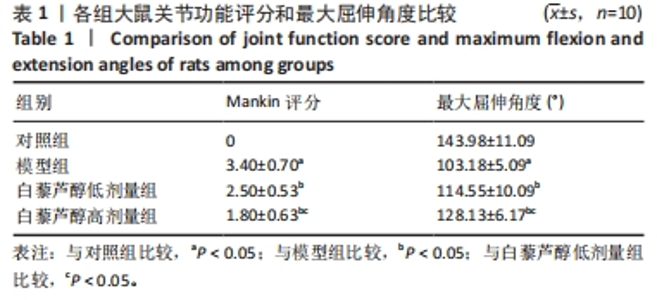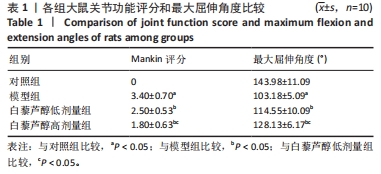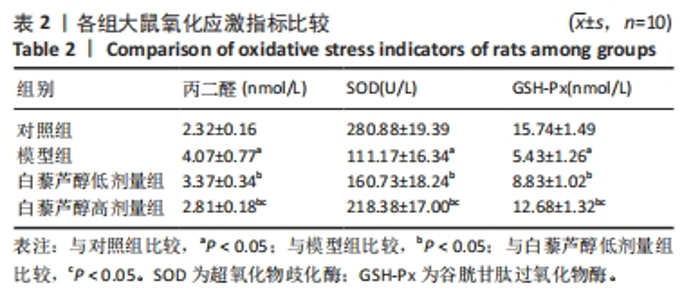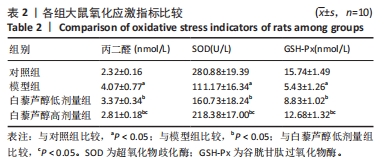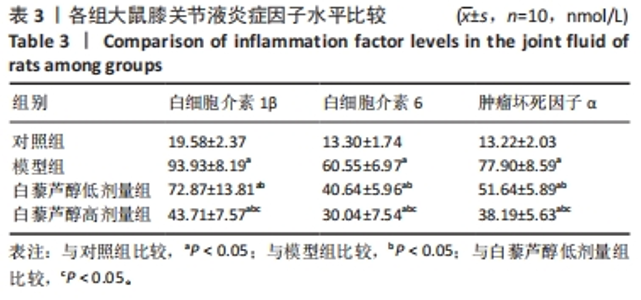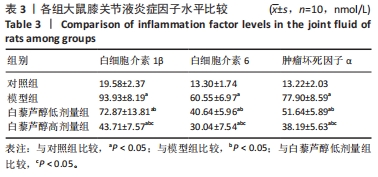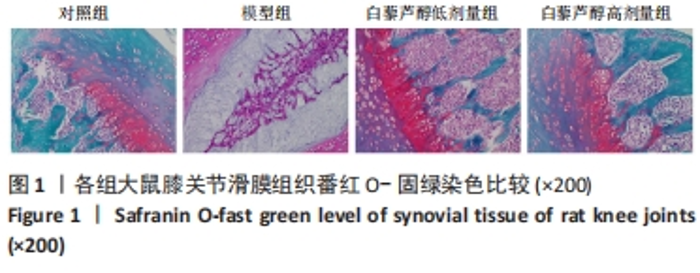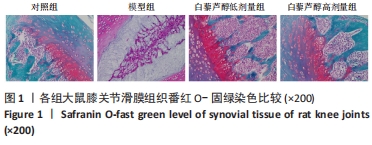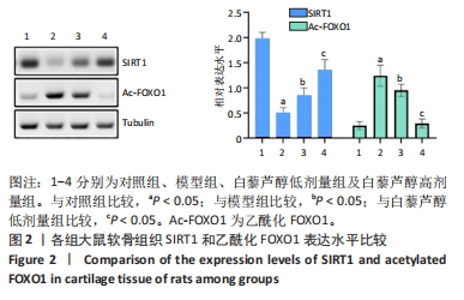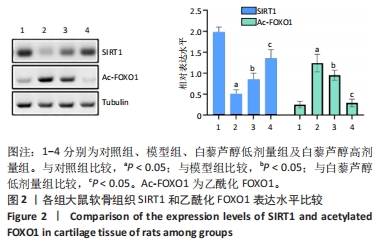[1] 陈景涛,陈有,李玉静,等. 黄芪多糖抑制Toll样受体4/核因子κB p65通路治疗大鼠膝骨关节炎[J]. 中国组织工程研究,2023,27(31):5002-5008.
[2] 章晓云,曾浩,孟林. 膝骨关节炎疼痛机制及治疗研究进展[J]. 中国疼痛医学杂志,2023,29(1):50-58.
[3] MICHAEL JW, SCHLÜTER-BRUST KU, EYSEL P. The epidemiology, etiology, diagnosis, and treatment of osteoarthritis of the knee. Dtsch Arztebl Int. 2010; 107(9):152-162.
[4] FENG K, CHEN Z, PENGCHENG L, et al. Quercetin attenuates oxidative stress-induced apoptosis via SIRT1/AMPK-mediated inhibition of ER stress in rat chondrocytes and prevents the progression of osteoarthritis in a rat model. J Cell Physiol. 2019;234(10):18192-18205.
[5] ZHUANG Y, WU H, WANG X, et al. Resveratrol Attenuates Oxidative Stress-Induced Intestinal Barrier Injury through PI3K/Akt-Mediated Nrf2 Signaling Pathway. Oxid Med Cell Longev. 2019;2019:7591840.
[6] 王瑜,梁超,王宝爱,等. 白藜芦醇激活PI3K/Akt信号通路与老年缺血性脑卒中大鼠血清IL-6、IL-1β含量的分子机制[J]. 中国老年学杂志,2023,43(3): 656-660.
[7] YANG Y, LIU Y, WANG Y, et al. Regulation of SIRT1 and Its Roles in Inflammation. Front Immunol. 2022;13:831168.
[8] 刘丽君,郑慧军.白藜芦醇对脑缺血再灌注损伤大鼠神经功能和肠道菌群的影响[J]. 中成药,2023,45(7):2384-2388.
[9] ALMEIDA M, PORTER RM. Sirtuins and FoxOs in osteoporosis and osteoarthritis. Bone. 2019;121:284-292.
[10] SHARMA L. Osteoarthritis of the Knee. N Engl J Med. 2021;384(1):51-59.
[11] 崔龙慷,李学飞,沈高波,等. 强骨饮治疗膝骨关节炎临床疗效及对血清炎症因子的影响[J]. 中国骨质疏松杂志,2023,29(1):41-45.
[12] YAMADA EF, BOBINSKI F, MARTINS DF, et al. Photobiomodulation therapy in knee osteoarthritis reduces oxidative stress and inflammatory cytokines in rats. J Biophotonics. 2020;13(1):e201900204.
[13] 孔涛,马彦博,杨自军,等. 白藜芦醇的生物学功能及作用机制[J]. 中国临床药理学杂志,2022,38(6):592-596.
[14] ZHOU DD, LUO M, HUANG SY, et al. Effects and Mechanisms of Resveratrol on Aging and Age-Related Diseases. Oxid Med Cell Longev. 2021;2021:9932218.
[15] XU D, LI Y, ZHANG B, et al. Resveratrol alleviate hypoxic pulmonary hypertension via anti-inflammation and anti-oxidant pathways in rats. Int J Med Sci. 2016; 13(12):942-954.
[16] 杜以宽,曾广龙,谭志超,等. 白花丹止痛喷雾剂对兔膝骨关节炎软骨组织病理形态及TNF-α、IL-6、MDA、SOD的影响[J]. 天然产物研究与开发,2017, 29(12):2036-2043.
[17] 陈竹青,张荣国. 重组人促红素β注射液对糖尿病腹膜透析患者SOD、GSH-PX、MDA及Hcy水平的影响[J]. 中国生化药物杂志,2017,37(2):136-138.
[18] KURZ B, JOST B, SCHÜNKE M. Dietary vitamins and selenium diminish the development of mechanically induced osteoarthritis and increase the expression of antioxidative enzymes in the knee joint of STR/1N mice. Osteoarthritis Cartilage. 2002;10(2):119-126.
[19] DU C, SMITH A, AVALOS M, et al. Blueberries Improve Pain, Gait Performance, and Inflammation in Individuals with Symptomatic Knee Osteoarthritis. Nutrients. 2019;11(2):290.
[20] DAINESE P, WYNGAERT KV, DE MITS S, et al. Association between knee inflammation and knee pain in patients with knee osteoarthritis: a systematic review. Osteoarthritis Cartilage. 2022;30(4):516-534.
[21] ORHAN C, TUZCU M, DURMUS AS, et al. Protective effect of a novel polyherbal formulation on experimentally induced osteoarthritis in a rat model. Biomed Pharmacother. 2022;151:113052.
[22] XU G, HE Z, LIU Y. Alisol A 24-acetate ameliorates osteoarthritis progression by inhibiting reactive oxygen species and inflammatory response through the AMPK/mTOR pathway. Immun Inflamm Dis. 2023;11(5):e848.
[23] 李杨涛,崔俊成,李金鑫,等. 前交叉韧带损伤后炎症因子致膝关节创伤后骨关节炎的研究进展[J]. 中南医学科学杂志,2023,51(2):174-177,217.
[24] 欧宝芳,别亚男,陈千晴,等. 改良后Hulth法和Ⅱ型胶原酶注射法建立兔膝骨关节炎模型的比较研究[J]. 中国比较医学杂志,2022,32(2):29-37.
[25] 史晓伟,王东峰,邓晓丰,等. 不同针刺方式对早期膝骨关节炎兔模型软骨细胞及Ⅱ型胶原蛋白代谢的影响[J]. 针灸临床杂志,2022,38(1):59-64.
[26] SINGH V, UBAID S. Role of Silent Information Regulator 1 (SIRT1) in Regulating Oxidative Stress and Inflammation. Inflammation. 2020;43(5):1589-1598.
[27] YANG Y, LIU Y, WANG Y, et al. Regulation of SIRT1 and Its Roles in Inflammation. Front Immunol. 2022;13:831168.
[28] JIANG S, ZHANG C, LU Y, et al. Mechanical stress-caused chondrocyte dysfunction and cartilage injury can be attenuated by dioscin via activating sirtuin1/forkhead box O1. J Biochem Mol Toxicol. 2022;36(12):e23212. |
